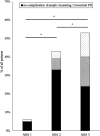High Rates of Aseptic Loosening After Revision Total Knee Arthroplasty for Periprosthetic Joint Infection
- PMID: 32984749
- PMCID: PMC7480970
- DOI: 10.2106/JBJS.OA.20.00026
High Rates of Aseptic Loosening After Revision Total Knee Arthroplasty for Periprosthetic Joint Infection
Abstract
With increasing life expectancy, the demand for knee replacement is continuously rising. Despite the use of antibiotic prophylaxis and improved aseptic surgical techniques, periprosthetic joint infection (PJI) still occurs in 1% to 5% of patients after primary arthroplasty. An open question is the influence of PJI and resulting surgical procedures on the occurrence of long-term complications such as aseptic loosening. Patients needing multiple revision surgeries are especially at risk for decreases in bone mass and damage to the medullary cavity. Thus, we theorized that prior surgeries on the affected knee increase the risk of aseptic loosening in patients with PJI.
Methods: We retrospectively analyzed the cases of 100 patients who underwent total knee replacement exchange surgery as a result of PJI. In addition to clinical, paraclinical, and radiographic examination, we assessed comorbidities and the number of prior surgeries.
Results: Prosthetic survival was drastically decreased after PJI-related revision arthroplasty: during the first 7.3 years after reimplantation, 22% and 16% of all patients had aseptic loosening and recurrent PJI, respectively. The prevalence of aseptic loosening was 27.8% for female and 15.2% for male patients. A significant association between increasing patients' American Society of Anesthesiologists (ASA) classification and prosthetic failure rates was found, as was a strong correlation between number of prior surgeries and aseptic loosening.
Conclusions: In this study, we found notable rates of aseptic loosening and recurrent PJI following PJI-related revision arthroplasty. The difference in the rate of aseptic loosening among male and female patients supports theories of the role of bone metabolism in the development of aseptic loosening. The economic and clinical burdens of prosthetic failure make it paramount to gain a better understanding of bone metabolism in PJI. Additional research should address the need to optimize treatment strategies to increase prosthetic survival.
Level of evidence: Therapeutic Level IV. See Instructions for Authors for a complete description of levels of evidence.
Copyright © 2020 The Authors. Published by The Journal of Bone and Joint Surgery, Incorporated. All rights reserved.
Conflict of interest statement
Figures




References
-
- Kurtz SM, Ong KL, Schmier J, Mowat F, Saleh K, Dybvik E, Kärrholm J, Garellick G, Havelin LI, Furnes O, Malchau H, Lau E. Future clinical and economic impact of revision total hip and knee arthroplasty. J Bone Joint Surg Am. 2007. October;89(Suppl 3):144-51. - PubMed
-
- Delanois RE, Mistry JB, Gwam CU, Mohamed NS, Choksi US, Mont MA. Current epidemiology of revision total knee arthroplasty in the United States. J Arthroplasty. 2017. September;32(9):2663-8. Epub 2017 Apr 6. - PubMed
-
- Kurtz SM, Lau E, Schmier J, Ong KL, Zhao K, Parvizi J. Infection burden for hip and knee arthroplasty in the United States. J Arthroplasty. 2008zOctober;23(7):984-91. Epub 2008 Apr 10. - PubMed
-
- Insall JN, Thompson FM, Brause BD. Two-stage reimplantation for the salvage of infected total knee arthroplasty. J Bone Joint Surg Am. 1983. October;65(8):1087-98. - PubMed
-
- Poss R, Thornhill TS, Ewald FC, Thomas WH, Batte NJ, Sledge CB. Factors influencing the incidence and outcome of infection following total joint arthroplasty. Clin Orthop Relat Res. 1984. Jan-Feb;182:117-26. - PubMed
LinkOut - more resources
Full Text Sources
Research Materials
